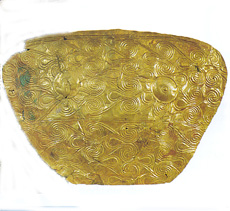 |
The Greek Age of Bronze
Corselet and Kiton |
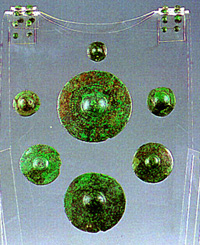 |
The utilization of light corselet and breast plates as protective elements seems to be attested in Aegean area since the 16th century BC.
Two golden plates (one plain one embossed) dated LH II (around 1500 BC) from the royal shaft-grave V in Mycenae have been both interpreted as ornaments laid on the dead person's clothes or ornaments of breast protection made of perishable material. |
| Nothing preclude the assumption that identical objects of bronze were used as a warrior's breast-protection in daily life, and that the gold pieces from the shaft-grave V were nothing but an imitation of those protection plates.
Their general design and in particular the representation of the nipple and the presence of buttons for fixation straps support such opinion. |
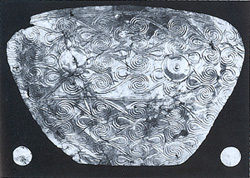 |
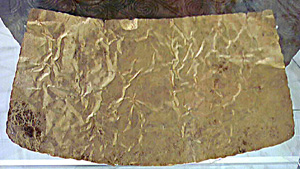 |
Of course we can't completely exclude the possibility that high rank warriors were equipped with gold protections or ornaments as part of their cuirasses, corselet and weaponry as also attested in the Iliad (*1). Even if the two golden plates are not absolute proof of a metal corselet, they are a strong indication of its use at the beginning of Achaean period. |
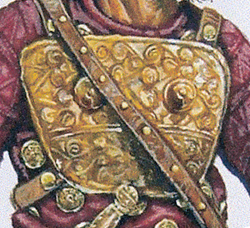 |
Based on the above mentioned elements a reasonable recontruction of a perishable material corselet with fixation straps reinforced with two plates at chest and back can be assumed. |
| A similar breast protection seems to be represented in a Hittite fragment of clay vessel from Bogazkoy dated around 1350 BC. In this images a warrior, who because of his general outfit has been interpreted by the scholars as one of the Ahhiyawa (Achaeans) warlord mentioned on several Hittite diplomatic tablets (see also the page dedicated to the Trojan war), seems to be equipped with a decorated breast protection which closer resemble the one found in the royal shaft-grave V in Mycenae.
|
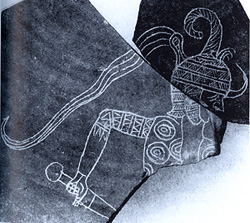 |
| Always from the royal shaft-grave in Mycenae a thick piece of cloth made of 14 layers of linen is probably the remain of a protective non metallic corselet or "kiton".The utilization of non metallic corselet is indeed also attested in the Iliad (*2). |
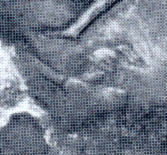 |
Possible evidence of this type of protective outfit is from the silver "rhyton" from Mycenae shaft-grave IV dated LH IB. In the siege scene represented in the "rhyton" one of the warrior is equipped with a conical helmet and what seems to be a short sleeve thick protective "Kiton". |
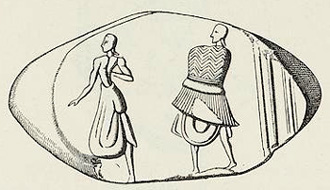 |
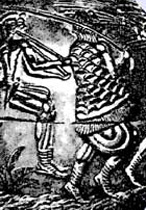 |
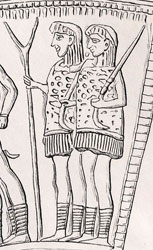 |
The outfit represented in this seal from Haghia Triada dated MM III- LM I (about 1600 BC) has been also interpreted as a possible quilted or metal reinforced corselet made of linen with a protective belt and lower "pteriges" style fringes worn over a " globular kiton". This interpretation is questionable and mostly of the scholars believe that the strange outfit is instead a ritual garment of a priest worn during a ritual cult. In fact this garment shows closer similarity with the one worn by a man in the famous Harvester Vase from Hagia Triada dated around 1500 BC and by two men (priestes ? harvesters ? country guards ?) represented on a minoan cup dated 1700-1550 BC. |
| Even if this bowman shown in this relief from the Knossos palace, dated XVI century BC, is normally interpreted as naked with short trousers, we can't completelly exclude that the longitudinal lines in the chest may represent a corselet probably made of thick stripes of cloth. |
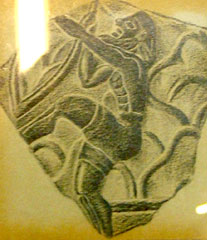 |
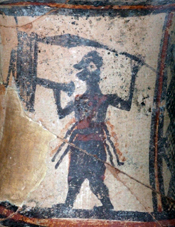 |
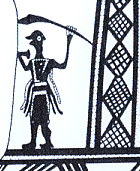 |
Another type of non metallic corselet with belt and strange fringes is represented in two jugs of Bichrome Wheelmade ware, from Cyprus dated about 1500 BC. |
|
| Protective elements of a possible linen corselet or kiton are the two fragments of copper trapezoidal plates (respectively 48 mm x 35 mm and 50 mm x 42 mm) found in Phaistos Crete "Tombe dei Nobili" dated LH IIB. These plates have holes around the edges with traces of quadruple linen or hemp thread that fastened the copper to a linen backing. From the same tomb there is also another copper plate fragment (295 mm x 120 mm) also with small holes for sewing the metal to some sort of backing and appears to belong to a cuirass. (see also the page dedicated to the cuirass)
|
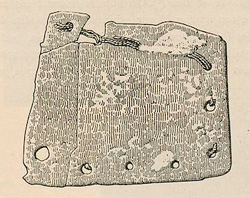 |
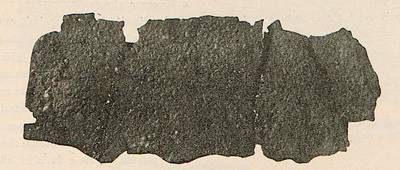 |
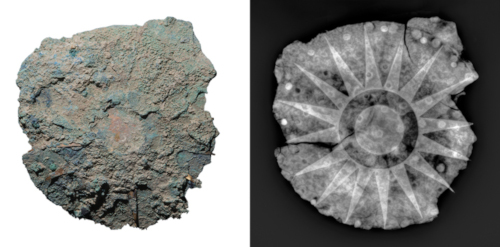 |
A heavily corroded bronze disk (left) with gold foil decorations and an X-ray of the disk (right) display a sun with 16 points that was likely attached to the warrior’s linen or lether armor has been found together other bronze band fragments in a rich warrior grave in Pylos dated around 1500-1420 BC.
This star motif remind the ones present in later bronze breast plates from Slovakia and thus support the hypothesis of the Aegean origin of some Slovakia cuirasses of the late Bronze Age. |
|
| For the subsequent periods several fresco representations of warriors and hunters from the palaces of Mycenae, Tyrins and Pylos show possible evidences of protective "Kiton" made of several layers of fabric. |
| From the "House of the oil merchant" in Mycenae a fresco dated LH IIIA (about 1370 BC) shows a greaved warrior equipped with a light colored "Kiton" with black dots and belt. Similar outfit is worn by some warriors from the "Megaron" fresco in Mycenae from the same period. |
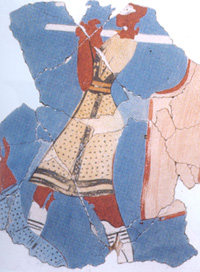 |
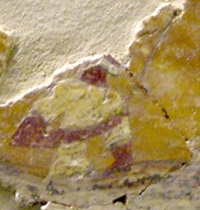 |
In another fresco from Mycenae probably dated LH IIIA/B (about 1350 BC) a warrior is represented with a "Kiton" and belt. The cross pattern on defence could be interpreted as a quilted "Kiton" made of several layer of fabric. |
| In a fresco from Tiryns dated LH IIIB (about 1300 BC) a warrior or hunter wears a "Kiton" with belt. Also in this case the lines could represent the seams of a thick fabric instead of simple decorative motif.
Similar outfits are show in several images of warriors and hunters from Pylos frescos dated from the same period. |
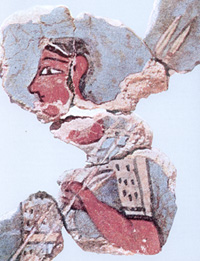 |
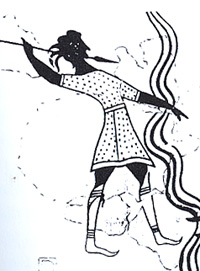 |
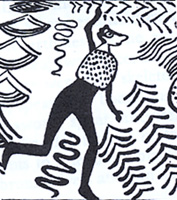 |
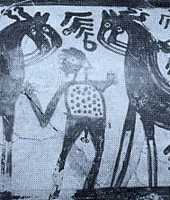 |
Waist-lenght dotted tunics or short corselets are represented in some pictorial vases from Cyprus dated around 1350 BC. These garments do not show a full oxhide patern, but are dotted, which may be a stylized version or the representation of decorative elements. The images on the right is one of the rare figures in Mycenaean art whose genitals are depicted. |
| These short tunics or corselets show similarity with the short-cropped corselet probably made of goat skin worn by a possible Aegean mercenary represented on the Tell El Amarna Papyrus. These corselets have never been represented in other Egyptian image of soldiery. The corselet shows on the papyrus has another relevant feature: a green copper based paint (originally representing metal) has been used to evidence the presence of metal reinforcements of the corselet around the neck, on the upper arms and on the lower edges. Also tablets in Linear B from Knossos (L693) attested the employment of linen tunics (ki-to) reinforced with bronze or copper fittings (e-pi-ko-to-ni-ja). |
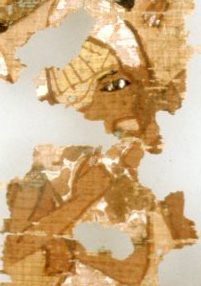 |
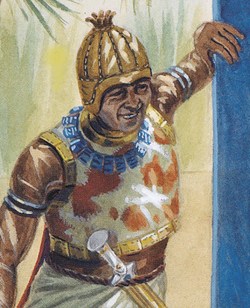 |
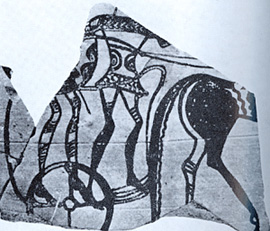 |
A very interesting image of a charioteer wearing a "Kiton", probably reinforced on chest and lower abdomen areas, and a large belt is depicted in a krater fragment from Tiryns dated LH IIIC (about 1200 BC). Because of its schematic style it is not clear if the "segmented" zones on upper and lower part of the outfit are decorative motif, quilted areas or metal (scale) reinforcements. Because a possible shoulder protection seems to be identifiable the last hypothesis could be the most reasonable (for further details and possible reconstruction of this defence and relevant belt see the page dedicated to the scale armour). |
Another interesting type of Achaean garment is shown in one seal-stone from Thisbe part of the controversial "treasure of seals"(*3) dated around 1500 BC. Also in this case the large spots on warrior's outfit could be interpreted as metallic elements instead of simple decoration motif.
This is probably the earliest representation of Aedipos against the Theban Sphinx. |
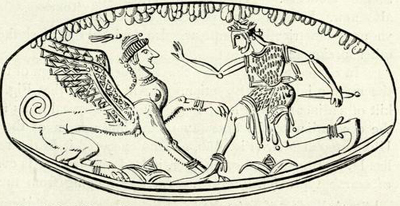 |
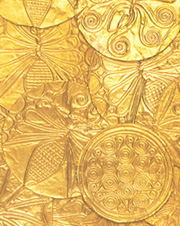 |
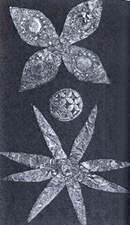 |
The large quantity of gold plaques from the royal shaft-graves of Mycenae used for cloths,"Kiton" or non metallic corselet decoration, could support this hypotesis. |
| In the chamber tomb 2 in Dendra dated around LH IIIA1 or LH IIIB a very interesting beaded garment was found. This element still showed a zig-zag pattern in yellow, brown, black, blue or white. |
| A simple but interesting garment with embroider edge is visible on a fresco from Pylos dated around LH IIIB (about 1300 BC). As represented in other similar frescoes this outfit was made of animal skin. |
| 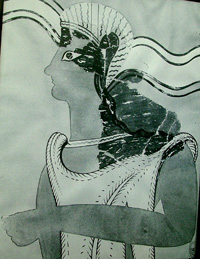 |
| Another possible type of Achaean defence is based on perishable material corselet reinforced on chest and probably back areas with bronze plates of different dimension. The utilization of these corselet is presumed by some findings in Archalochori, probably in Pylos and probably in Liatovouni.
|
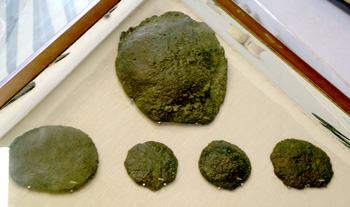 |
Five bronze round plates dated around 1500 BC have been found in Archalochori Crete. The size of the plates are respectively about 150 mm in diameter for the larger one, about 100 mm for the medium and about 50-60 for the three smaller ones. Small holes barely visible all around the plates edge were used for their fixation to a perishable material corselet. |
|
| Similar bronze elements dated around LH IIIB have been also found, together some weapons, in Pylos. In this case their identification as elements from a protective corselet is questionable being their dimensions and general appearance similar to some mirrors found in other excavations.
|
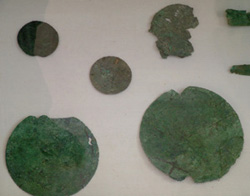 |
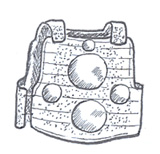 |
Based on the above mentioned elements a possible reconstruction of a perishable material corselet reinforced with bronze plates can be assumed. Of course the bronze element location is only indicative and not necessarily correspond to the real position of the plates. |
|
| The most remarkable finding of a possible similar reinforced corselet is from a cemetery excavated on Liatovouni hill, which rises from the Konitsa plain in north west of Greece mainland (*3a). In a warrior burial dated 13th-12th Century BC two bronze swords, two spear-heads seven bronze plates and several small bronze buttons have been found. The bronze plates and the buttoms have been also explain as protections and fixation elements of a perishable material corselet. The larger plates are respectively 150 mm and 100 mm in diameter, two are large about 80 mm, the other two 60 mm and the small one 30 mm. Indeed because their shape, which is very similar to some shield bosses found in other late Achaean graves, the circular plates have been also interpreted as shield's bosses belong to a large or two medium size shields. (see also the page dedicated to the round shields). In this case only the small bronze buttons could have been parts of a non metallic corselet or possible reinforcement elements of a leather helmet.
|
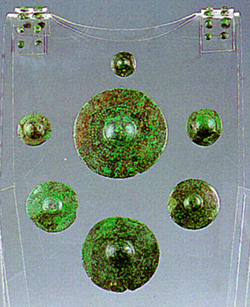 |
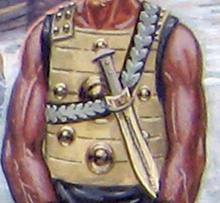 |
Also in this case the archaeological reconstruction of a possible perishable material corselet reinforced with the bronze plates and buttoms from Liatovouni is only indicative and the bronze elements location not necessarily correspond to the real position of the plates. |
|
| A possible corselet reinforced with two large embossed round plate at chest level could be worn by the rowing warriors represented on this sherd of an Achaean krater from Voudeni dated around 1200-1100 BC. |
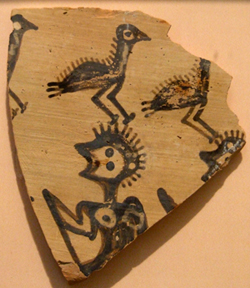 |
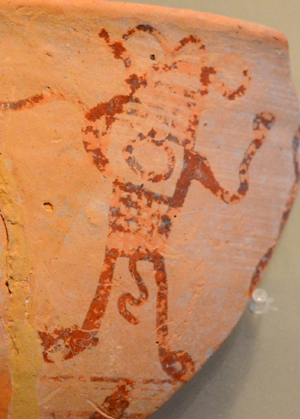 |
A possible warrior with cuirass or corselet with neck protections seems depicted on this pottery from Nemea dated LH IIIA2 (about 1350-1300 BC)
|
| Even if the bronze trips and embosed rows from Kallithea dated about LH IIIC has been now identify as part of a "Tiara like" helmet (see also the page dedicated to the late helmet), we can't exclude that similat elements could have been also used as decorative and reinforcement parts for some corselets made of perishable materials.
|
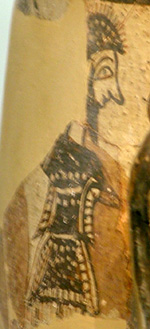 |
Possible pictorial evidence of bronze strips similar to the ones from Kallithea is represented on the warriors on the back side of the "warriors vase" from Mycenae dated LH IIIB. The corselet of the soldiers seems to be reinforced at chest level with two embossed and one central plain strips which show reasonably similarity with the bronze elements from Kallithea being also dated at the same period. Also the white dots on "Kiton" and helmet could be interpreted as bronze reinforcement bosses probably of the same type found in Kallithea |
|
| Based on "warriors vase" representation and Kallithea finding a possible reconstruction of a perishable material corselet with reinforcement strips at chest level can be assumed. |
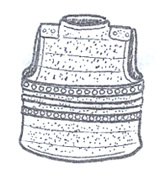 |
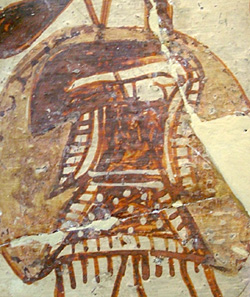 |
Another type of late Achaean protection corselet is the one worn by the soldiers on "warriors vase" and stele from Mycenae both dated LH IIIC. This defence seems to be composed as a segmental "poncho" which cover the breast and back of the warrior. Even if generally interpreted as made of linen or other perishable material we can't exclude that narrow bronze strips could have been added as reinforcements. Some of the narrow plates from Mycenae and Thebes (see the page dedicated to the armour) could also have been elements of a such "poncho". |
|
| A possible support of this theory comes from the colourful representation on a stele from Mycenae (probably made from the same artist of the warrior vase) where the "poncho" corselet are depicted in red/orange colour the same used for the warriors' spear points. Of course because the artistic stylization and bad preservation of the stele both the hypothesis are reasonably acceptable as well as the consideration that some of these defences could be reinforced with bronze scale (see the page dedicated to the scale armour). |
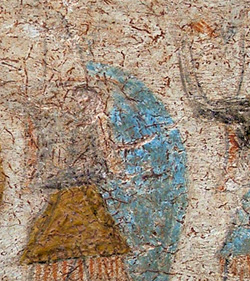 |
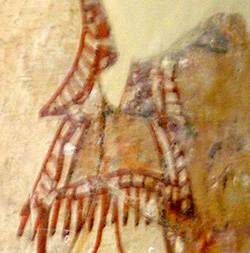 |
On the warrior vase is also well represented the presence of protections in the lower part of the warriors' body similar in design to the "poncho" corselet. Because this defence seems to be separate from the "kiton" it could be interpreted as a Mitra" also in this case made of perishable material possible reinforced with bronze strips or scales and attached to a waist belt or in the lower edge of the cuirass/corselet. |
|
| Based on the artistic representation and the bronze elements found in several Achaean sites, a possible reconstruction of such kind of defence based on a body corselet and "Mitra" can be reasonably made, both as simple decorated multiple layers or quilted perishable material corselet or reinforced with bronze strips. |
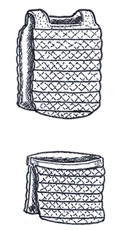 |
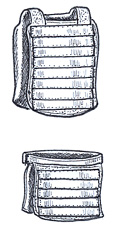 |
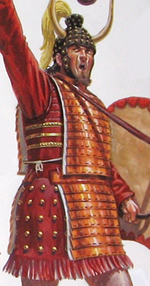 |
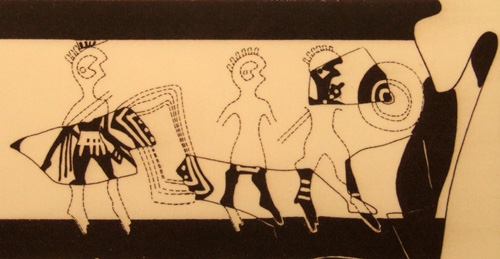 |
A skirt protections similar to the later periods "pteryges" seem depicted in the left warrior of this krater fragment from Thermon dated around the second half of the 11th century BC (*6). These kind of lower protection strips worn around the waist were made of perishable material like linen or leather. The central warrior seem instead wearing a sort of lower abdomen protection "mitra". (drawing by Diana Wardle)
|
|
| Another type of late corselet is represented in two ivory mirror handles dated 12th Century BC respectively from Kouklia and Enkomi Cyprus. In these reliefs two warrior fighting against a lion and a gryphon were wearing a mix of Aegean and Oriental outfit in particular the corselet is made of inverted V bands probably made of linen or overlapped ("lobster style") bronze strips.
| 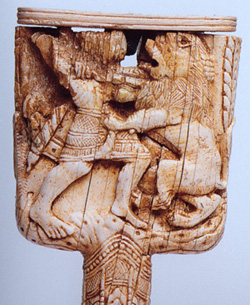 |
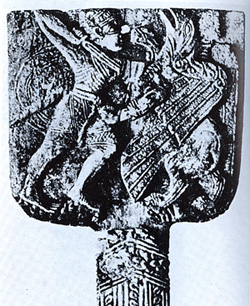 |
|
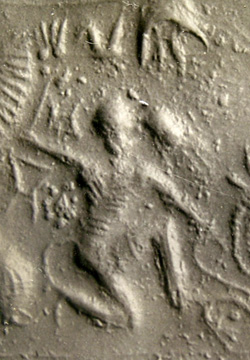 |
Similar banded corselet seems also worn by the warrior represented in this hematite cylinder always from Cyprus dated 13th Century BC
|
|
| Based on the artistic representation on the Cypriote ivory handles, a possible reconstruction of such kind of defences can be reasonably made, both as simple decorated multiple layers or quilted perishable material corselet or as "lobster style" bronze corselet. |
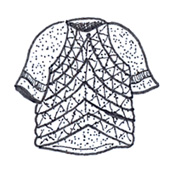 |
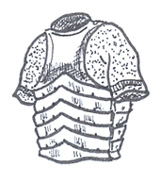 |
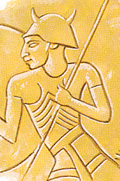 |
These defence are similar to the ones worn by the Sherden and Peleset which were some of the "Sea people" represented in the Medinet Habu Egyptian temple (see also the page dedicated to the Sea People). |
|
| CORSELET IN THE LINEAR B
|
| In a single Linear B tablet from Knossos (KN K740) we have the representation of the ideogram for the term qe-ro2 which seems to represent a simple corselet made of two bronze plates being the double lines the figurative representation of two elements. |
|
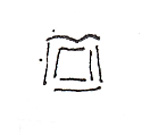 |
Even if some scholars had interpreted such symbol as the two elements of the typical cuirass (*4) we have to considered that in the same period the armour torso plates were jointed by lateral fastening system and that the term qe-ro2 was normally used as dual. These elements led to a possible conclusion that the symbol is more likely related to the bronze elements of a simple corselet composed by two squared or trapezoidal plates for chest and back protection jointed by simple leather strips. Furthermore on the tablets where the word qe-ro2 appeared, only one time it is used as plural being followed by the bronze ideogram. Indeed in three cases the presence of other supplemental elements of the defence are also attested. |
|
| in the Linear B tablets from Knossos a simplified variant of the cuirass symbol is represented. Such ideogram is always used with a syllabic KI, RI or QE which probably was used for a more precise identification. When this symbol is jointed with QE (that is considered the phonic short form for qe-ro2) more likely it indicate a "Kiton" or non metallic cuirass where two qe-ro2 was added (*5). This representation was probably utilized when a much simple defence (respect to the typical full armour or cuirass) composed by two plates for chest and back protection was used without other elements. |
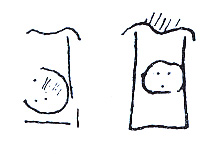 |
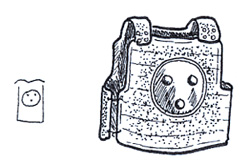 |
Based on the Knossos tablet ideogram and on corselet plates found in Archalochori Crete and Liatovouni a possible representaton of such defence can be reasonably assumed. It was basicaly a perishable material corselt reinforced with two large embossed circular bronze plates qe-ro2 for chest and back protection. |
|
| CENTRAL EUROPE CORSELETS
|
| From the rest of Europe worthy to be mentioned are some bronze plates and elements probably reinforcement of leather or linen corselets found in Austria, because their vicinity with the Achaean mainland and because they fall to the same time period as the Greek Bronze Age civilization, either before or after the collapse of the palace system.
|
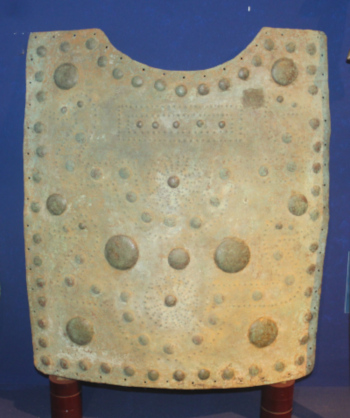 |
A well preserved embossed and decorated bronze breast plate found in Austria dated about 1200-1000 BC. This bronze plate was attached to a perishable materail corselet probably made of leather or linen.
|
| Two bronze plates from the same area in Austria also dated around 1200 1000 BC have been interpreted as reinforcement elements of a perishable material corselet
|
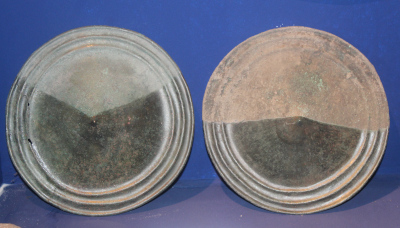 |
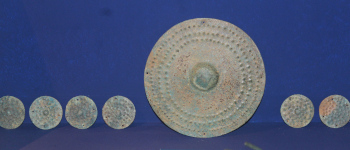 |
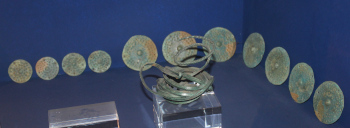 |
Several embossed bronze plates reinforced elements of a leather corselet have been also found in the same area in Austria.
|
| A very intersting group of 533 bronze embossed discs have been found always in Austria. These reinforced and decorative elements of a perishable material corselet have been found in a grave dated 1300-1200 BC
|
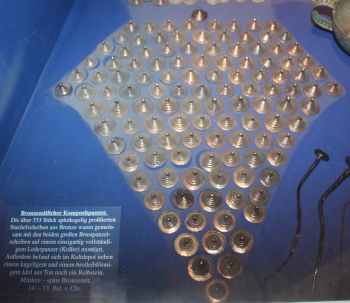 |
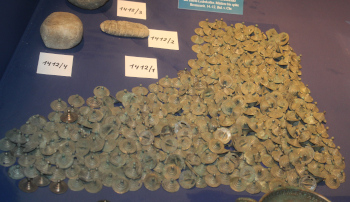 |
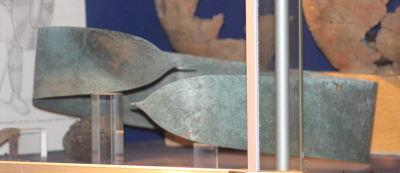 |
 |
Some decorated bronze belts dated 1200-1000 BC have been also found in the same area in Austria.
|
| CONCLUSION
|
| The finding and artistic representaton give a good evidence about the continuous utilization of corselet/breast protections and multi-layer "kiton" in Aegean area during the all Late Helladic period. Thick protective garments as well as higly decorated or gold platted breast protections were used by high rank people since the 16th century BC thus before the apperance of the first (so far known) bronze armour.
After the introduction of the more elaborate and prestigious bronze cuirass, the simple corselet sometime reinforced with bronze plates were more likely used by medium/low rank people. These simplified defence are also attested in the Linear B tablets from Knossos where these equipments as well as the cuirass elements were supplied by the palace authority as parts of the warriors' equipment or as replacements for missing elements of the soldier's personal defence.
In the late Achaean period the medium/low rank warriors seem to be also equipped with another kind of perishable material corselet reinforced with plain and embossed bronze strips in different shape and quantity. The significative findings from the warrior grave A in Kallithea and the artistic representation in Mycenae could give possible evidence about the usage of these defence. For the Achaeans located in the Anatolian coast area and islands the use of a mix of Aegean and Near Eastern outfit and defence elements which in some cases have significative correspondance with some of the "Sea People" protective garments are also attested.
|
(*3) The autenticity of the seal-stones from Thisbe "treasure of seals" is actually questionable, nevertheless their iconography model are significative and more likely are based on true specimens.
|
(*3a)DAVID BLACKMAN, Archaeology in Greece 1999-2000. ISSN 0570-6084; Publihed by the council of the society for the promotion of hellenic studies and the managing committee of the British school at Athens 2000.
|
(*4)The Hypotesis is in contrast with the fact that when qe-ro2 is used at the plural (K 740) seems to be not a neutral sostantive but a male in -os. PALMER, Interpretation, p. 333; LEJEUNE, Minos 9, 1968 p. 55; M. DORIA, Avviamento allo studio del miceneo, Roma 1965, p. 205.
|
(*5)PALMER, Interpretation, p. 488; SNODGRASS, Kadmos 4, 1965, p.101.
|
(*6)Wardle and Wardle ‘Prehistoric Thermon: pottery of the Late Bronze and Early Iron Age’ eds. N. Kyparissi-Apostolika, M. Papakonstantinou, The Periphery of the Mycenaean World II, 147-156 2003.
|
|